Recruitment of latent pools of high-avidity CD8(+) T cells to the antitumor immune response
- PMID: 15883172
- PMCID: PMC2212915
- DOI: 10.1084/jem.20042167
Recruitment of latent pools of high-avidity CD8(+) T cells to the antitumor immune response
Abstract
A major barrier to successful antitumor vaccination is tolerance of high-avidity T cells specific to tumor antigens. In keeping with this notion, HER-2/neu (neu)-targeted vaccines, which raise strong CD8(+) T cell responses to a dominant peptide (RNEU(420-429)) in WT FVB/N mice and protect them from a neu-expressing tumor challenge, fail to do so in MMTV-neu (neu-N) transgenic mice. However, treatment of neu-N mice with vaccine and cyclophosphamide-containing chemotherapy resulted in tumor protection in a proportion of mice. This effect was specifically abrogated by the transfer of neu-N-derived CD4(+)CD25(+) T cells. RNEU(420-429)-specific CD8(+) T cells were identified only in neu-N mice given vaccine and cyclophosphamide chemotherapy which rejected tumor challenge. Tetramer-binding studies demonstrated that cyclophosphamide pretreatment allowed the activation of high-avidity RNEU(420-429)-specific CD8(+) T cells comparable to those generated from vaccinated FVB/N mice. Cyclophosphamide seemed to inhibit regulatory T (T reg) cells by selectively depleting the cycling population of CD4(+)CD25(+) T cells in neu-N mice. These findings demonstrate that neu-N mice possess latent pools of high-avidity neu-specific CD8(+) T cells that can be recruited to produce an effective antitumor response if T reg cells are blocked or removed by using approaches such as administration of cyclophosphamide before vaccination.
Figures

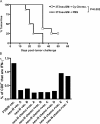
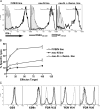

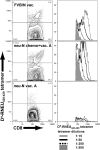
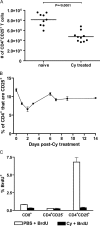
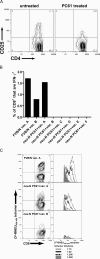

Similar articles
-
Nondominant CD8 T cells are active players in the vaccine-induced antitumor immune response.J Immunol. 2011 Apr 1;186(7):3847-57. doi: 10.4049/jimmunol.1000361. Epub 2011 Feb 23. J Immunol. 2011. PMID: 21346233 Free PMC article.
-
HSP110-HER2/neu chaperone complex vaccine induces protective immunity against spontaneous mammary tumors in HER-2/neu transgenic mice.J Immunol. 2003 Oct 15;171(8):4054-61. doi: 10.4049/jimmunol.171.8.4054. J Immunol. 2003. PMID: 14530326
-
Cyclophosphamide, doxorubicin, and paclitaxel enhance the antitumor immune response of granulocyte/macrophage-colony stimulating factor-secreting whole-cell vaccines in HER-2/neu tolerized mice.Cancer Res. 2001 May 1;61(9):3689-97. Cancer Res. 2001. PMID: 11325840
-
Cancer vaccines: progress reveals new complexities.J Clin Invest. 2002 Aug;110(3):289-94. doi: 10.1172/JCI16216. J Clin Invest. 2002. PMID: 12163445 Free PMC article. Review. No abstract available.
-
Mobilizing the low-avidity T cell repertoire to kill tumors.Semin Cancer Biol. 2007 Aug;17(4):317-29. doi: 10.1016/j.semcancer.2007.06.006. Epub 2007 Jun 23. Semin Cancer Biol. 2007. PMID: 17651986 Free PMC article. Review.
Cited by
-
Experimental mouse tumour models: what can be learnt about human cancer immunology?Nat Rev Immunol. 2011 Dec 2;12(1):61-6. doi: 10.1038/nri3129. Nat Rev Immunol. 2011. PMID: 22134155 Review.
-
Re-purposing cancer therapeutics for breast cancer immunotherapy.Cancer Immunol Immunother. 2012 Aug;61(8):1299-305. doi: 10.1007/s00262-012-1247-z. Epub 2012 Mar 28. Cancer Immunol Immunother. 2012. PMID: 22454154 Free PMC article. Review.
-
Alkylating chemotherapy may exert a uniquely deleterious effect upon neo-antigen-targeting anticancer vaccination.Oncoimmunology. 2013 Oct 1;2(10):e26294. doi: 10.4161/onci.26294. Epub 2013 Oct 15. Oncoimmunology. 2013. PMID: 24251080 Free PMC article.
-
Allogeneic tumor cell vaccines: the promise and limitations in clinical trials.Hum Vaccin Immunother. 2014;10(1):52-63. doi: 10.4161/hv.26568. Epub 2013 Sep 24. Hum Vaccin Immunother. 2014. PMID: 24064957 Free PMC article. Review.
-
Adaptive antiviral immunity is a determinant of the therapeutic success of oncolytic virotherapy.Mol Ther. 2011 Feb;19(2):335-44. doi: 10.1038/mt.2010.264. Epub 2010 Nov 30. Mol Ther. 2011. PMID: 21119618 Free PMC article.
References
-
- Sprent, J., and H. Kishimoto. 2002. The thymus and negative selection. Immunol. Rev. 185:126–135. - PubMed
-
- Walker, L.S., and A.K. Abbas. 2002. The enemy within: keeping self-reactive T cells at bay in the periphery. Nat. Rev. Immunol. 2:11–19. - PubMed
-
- O'Garra, A., and P. Vieira. 2004. Regulatory T cells and mechanisms of immune system control. Nat. Med. 10:801–805. - PubMed
-
- Pardoll, D. 2003. Does the immune system see tumors as foreign or self? Annu. Rev. Immunol. 21:807–839. - PubMed
-
- Disis, M.L., and M.A. Cheever. 1997. HER-2/neu protein: a target for antigen-specific immunotherapy of human cancer. Adv. Cancer Res. 71:343–371. - PubMed
Publication types
MeSH terms
Substances
Grants and funding
LinkOut - more resources
Full Text Sources
Other Literature Sources
Molecular Biology Databases
Research Materials
Miscellaneous

